A different kind of trend
- “Life moves pretty fast. If you don’t stop and look around once in a while you could miss it” Ferris Bueller’s Day Off
Despite being released only a year after this writer was born Ferris Bueller was one of our favourite movies growing up. A movie about living in the moment, friendship and self discovery – what was there not to like? For us it highlighted the importance of fun (we try to enjoy ourselves irrespective of performance) and the occasional break from routine so we don’t miss out on what life is really all about.
Most of us in markets would confess to at some point having focused on the day to day rather than zooming out a bit. Whether it be the minutia of the macro watch on inflation, growth and hence interest rates, it can have us sometimes miss the forest for the trees.
At Chester Asset Management we do keep an eye on the economic environment as it is increasingly influential in where we invest, particularly in a macro heavy market such as the ASX, however we acknowledge that trying to pick winners and losers off short term macro data can be inherently fraught with danger due to the impacts of government intervention in stimulating specific sectors of the economy. One way we try to circumvent this is to focus on underlying megatrends. Some of our investors or people who have heard from us may be familiar with a version of the below slide, we have been rolling with it for 7 years with minimal changes, because that’s the thing about megatrends.
Below we try to summarise the key points around demographics for the two most populous nations on the planet; China and India, as well as Australia and try to provide insights in how these demographic trends may influence key market sectors into the future.
China Demographics – The cyclical impacts of famine and ‘feasting’
As a consequence of questionable economic policies in China from 1958-1959 when millions of farmers were pulled off the land to engage in ill-advised rural industries, China suffered near famine conditions between 1959 and 1962. It is estimated (given the Government never officially acknowledged the famine) that it caused up to 40 million deaths. The presumed psychological impact of the famine (I know what I want to do when I’m hungry) was a heightened fertility rate, which saw the population boom between 1963 to 1973, from ~680 to 880 million people.
The growth was so rapid the Government was shocked into action, introducing the “later, longer, fewer” campaign which encouraged later marriage, longer gaps between kids and fewer children. The fertility rate (children per woman) in the 1970s subsequently dropped from 5.8 to 2.4. Despite the drop the Government went one step further in the 1980s by introducing the infamous one child policy.
The combination of the famine, baby boom, government reaction and fertility decline created what became known as a demographic dividend, evident from the dependency ratio; the number of young people (under 15) and old people (over 65) for every 100 working age people falling from 80 in 1975 to 36 in 2010!
The demographic dividend helped contribute to
China’s rapid growth over this time. However, as all market participants
(except maybe the crypto and tech bros) know about tailwinds they will
eventually become headwinds, it just depends on your time reference. Hence, as the baby boom workers from the 1960s
and 1970s become retirees and the impact of the one child policy shrinks the
workforce it leads to an increasing dependency ratio. I.e. in 2022 it is
estimated that there were under 50 people outside the working age population
(i.e. aged 0 to 14 or >65) to 100 people in it. Focusing on just the over 65
dependents, at present, each retiree is supported by the contributions of five
workers. The ratio is half what it was a decade ago and, per the graph below is
trending towards 4-to-1 in 2030 and 2-to-1 in 2050.
Some specific actions to combat this dependency issue are:
- Relaxing the one child policy. This policy update was announced in 2016 to two children and amended to three children in 2021.
Increasing the retirement age and trying to shift to more of a service based economy so the labour force can work for longer. The current retirement age in China is ~60 years old for men, 55 for female civil servants and 50 for female workers. In 2023 reports emerged that China was planning to raise its retirement age gradually and in phases to cope with this demographic challenge they face. The president of the Chinese Academy of Labour and Social Sciences in 2023 was quoted as stating that there was a “progressive, flexible and differentiated path to raising the retirement age” i.e. there is no specific timeline to implementation
Instituting a universal pension plan. The pension plan now effectively consists of three pillars the first of which was introduced in 1997 with a basic pension system in the 1990s. The second layer, enterprise annuities was introduced in 2004 and in 2022 the third layer, individual retirement accounts (IRAs) were launched. There was a notable push for adoption between 2009 and 2013 when China effectively tripled the number of people covered by the old-age pension system.
Increasing the level of automation (and or focusing on productivity). We suspect the government will provide further incentives for automation and R&D into AI but there is another underlying issue at play in China that this can impact so it is a delicate situation. China’s youth unemployment rate is currently hovering around 15.
On another note, China has net negative migration, more people permanently leaving the country than entering which further exacerbates the issue around working age population. In 2023 alone the WorldBank estimated China’s net migration at (310k). Note this contrasts with Australia, where some of the issues of the Baby Boomer generation have been somewhat circumvented by an expansionary migration policy, refer comments below.
India Demographics – A more sustainable dividend
Similar to China, India's demographic dynamics have been influenced by government actions, economic conditions, and social norms, leading to significant shifts in its population structure over the decades.
India was rocked during the mid 20th century by famines, the first of which, the Bengal famine of 1943, occurred during World War II as a combination of food procurement for the war and crop failure. The Bengal Famine was thought to have caused the deaths of some 3 million people. Famine conditions also re-occurred in 1966 and 1972 as a result of drought but not to the same extent.
The situation began to improve with the ‘Green Revolution’ in the 1960s, which introduced high-yielding variety seeds, improved irrigation infrastructure, and modern agricultural techniques such as mechanized farm tools, pesticides and fertilisers. This transformation in agriculture not only helped avert famine but also led to a significant increase in food production.
The improved food security contributed to a population boom. However, India also benefited from improvement in living standards which helped see a meaningful decline in mortality rates as health conditions improved and life expectancy increased. Between 1960 and 1980, India's population grew from approximately 450 million to 700 million.
Recognizing the challenges of managing such a large and rapidly growing population, the Indian Government initiated various family planning programs. During ‘the Emergency Period’ from 1975 to 1977, under prime minister Indira Gandhi, a controversial and coercive sterilization campaign was launched. There were even reports of police cordoning off villages and dragging men to surgery. It was believed that during 1975 ~6m Indian men were sterilized in just a year, a number reported to be 15x the number of people sterilized by the nazis in World War II(1). This led to a decline in the fertility rate but also sparked public outrage and political backlash. Whether it kickstarted the decline in the fertility rate further we’ll never know but the drop, per the graph below is quite stark since the Emergency Period began.
In the subsequent decades, the Government shifted to more voluntary and incentive-based family planning measures. The introduction of widespread education about family planning, improved access to contraception, and economic incentives for smaller families gradually led to a decline in fertility rates. For context this has seen the fertility rate drop from ~6 children per woman in the 1960s to 3-4 in the 1990s and closer to 2.2 today.
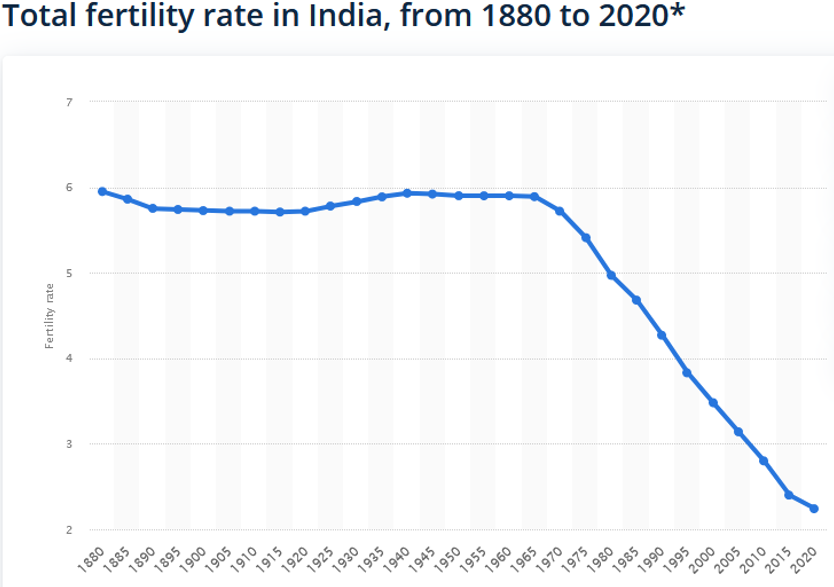
Source: Statista 2024
India's population, unlike China’s has created a demographic dividend, defined as the economic growth potential resulting from changes in a country's age structure. This began to emerge prominently in the late 20th century. With a larger proportion of the population entering the working-age group, the dependency ratio declined. This shift provided India with a substantial labour force, contributing to economic growth and increased productivity.
From 1991 to 2018 India experienced a period of rapid economic growth, often attributed to liberalisation policies, increased foreign investment, and the rise of the IT sector. The growing working-age population played a crucial role in this economic expansion, as it fueled consumer demand, increased savings, and enhanced the labor supply. This period of prosperity has contributed to ongoing population growth with India reportedly overtaking China as the most populous nation in 2023 but unlike China, India’s population is anticipated to keep growing until ~2065.
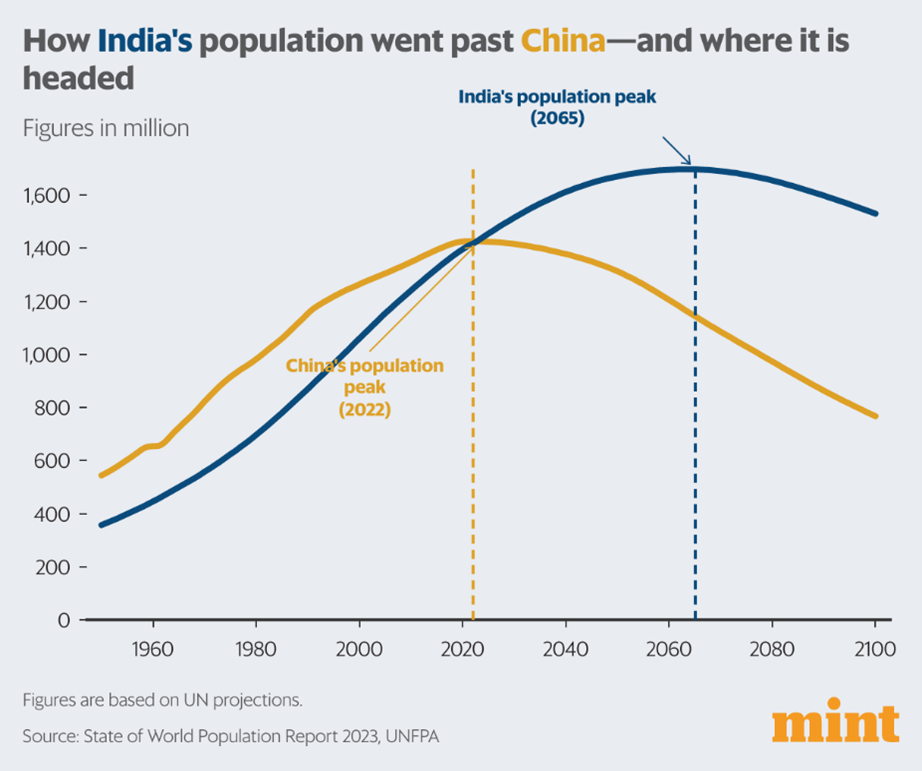
Today India has ~65% of its population under 35 years old! As the country’s population continues to age though, the demographic dividend is gradually diminishing. By 2050, the proportion of people aged 60 and over is expected to increase significantly, leading to a rising dependency ratio. UN estimates that the number of people aged 60 and over will increase from 149m in 2022 to 347m in 2050.
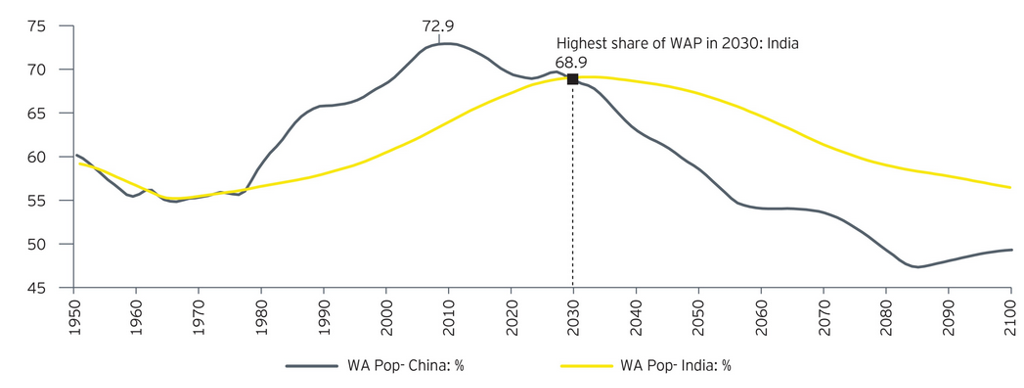
To address India’s demographic situation, the Government is implementing several measures:
- Promoting higher fertility rates: Unlike China, India's fertility rate of around 2.1, remains close to replacement level. However, efforts are being made to ensure it does not fall below sustainable levels through initiatives that support families, such as parental leave policies and financial incentives.
- Improving healthcare and social security: The government is working to strengthen healthcare infrastructure and expand social security programs to support the ageing population. This includes initiatives like the National Health Mission and the Pradhan Mantri Jan Arogya Yojana (PM-JAY), which aim to provide affordable healthcare to all citizens.
- Encouraging skill development: To harness the potential of the young working-age population, India is investing heavily in skill development programs. Initiatives like Skill India and the National Skill Development Mission aim to equip the workforce with the necessary skills to meet the demands of a modern economy.
- Boosting economic growth through innovation: The Indian government is promoting innovation and entrepreneurship to create new job opportunities and drive economic growth. Programs like Startup India and Make in India are designed to foster a business-friendly environment and attract investments.
By investing in healthcare, education, and skill development, and by fostering a conducive environment for economic innovation, India can navigate its demographic transition and continue its journey toward sustainable development and prosperity. We further note however that India’s national elections have just concluded with a surprise result that unlike 2015 and 2019 the Bhartiya Janata Party (BJP) didn’t win in a landslide. Hence despite Modi securing a third term he has had to form a coalition government for the first time. This means that Modi won’t have the same level of support during this term and will need to navigate coalition politics.
Australia Demographics – Why continue to build local when it’s easier to import?
Australia’s demographic landscape is a fascinating reflection of its economic policies, migration trends, and social changes. Over the past several decades, these factors have shaped the country's population dynamics, leading to significant shifts in age structure and workforce composition. It bears many similarities to a number of other western countries such as the US.
In the aftermath of World War II, Australia embarked on an ambitious immigration program to boost its population and workforce. The government actively encouraged immigration from Europe, resulting in a significant influx of new residents. This period saw Australia's population grow rapidly from ~7.5 million to over 13 million people by the early 1970s.
The increase in population was driven not only by immigration but also by a post-war baby boom. The fertility rate peaked in the late 1950s and early 1960s, with an average of 3.5 children per woman. My grandparents helped lift the average! This population growth provided a substantial boost to the economy, as a larger workforce supported industrial expansion and infrastructure development.
By the 1970s, Australia began to experience a decline in fertility rates, similar to trends observed in other developed countries. Several factors contributed to this decline, including increased access to contraception, greater participation of women in the workforce, and shifts in social attitudes towards family size. By the 1980s, the fertility rate had fallen to around 1.9 children per woman.
In response to these demographic changes, the Australian government implemented policies aimed at supporting families and encouraging higher fertility rates, some of which are addressed below. Migration has also continued to play a crucial role in shaping Australia's demographic profile. The government has maintained a robust immigration program, targeting skilled migrants to address labour shortages and support economic growth. This approach has helped offset the natural decline in fertility rates and ensured a steady increase in population. In recent years, Australia has also focused on attracting international students and temporary workers, further diversifying the population and contributing to the economy. The combination of permanent and temporary migration has allowed Australia to maintain a relatively young and dynamic workforce compared to other developed nations.
Australia's own demographic dividend became evident as the proportion of working-age individuals increased relative to dependents. From the 1970s to the early 2000s, the dependency ratio declined, providing a boost to the economy. During this period, Australia experienced sustained economic growth, supported by a strong labour force, high levels of productivity, and a favourable global economic environment. The mining boom in the early 2000s further fueled economic expansion, attracting investment and creating jobs.
Similar to India, as Australia's population continues to age, the demographic dividend is reducing. The proportion of people aged 65 and over is projected to increase significantly, leading to a rising dependency ratio. By 2050, it is expected that there will be around 3 working-age individuals for every senior citizen, compared to around 5 in the late 2000s.
The current fertility rate in Australia is 1.6, well below the replacement rate of ~2.1 births per woman.
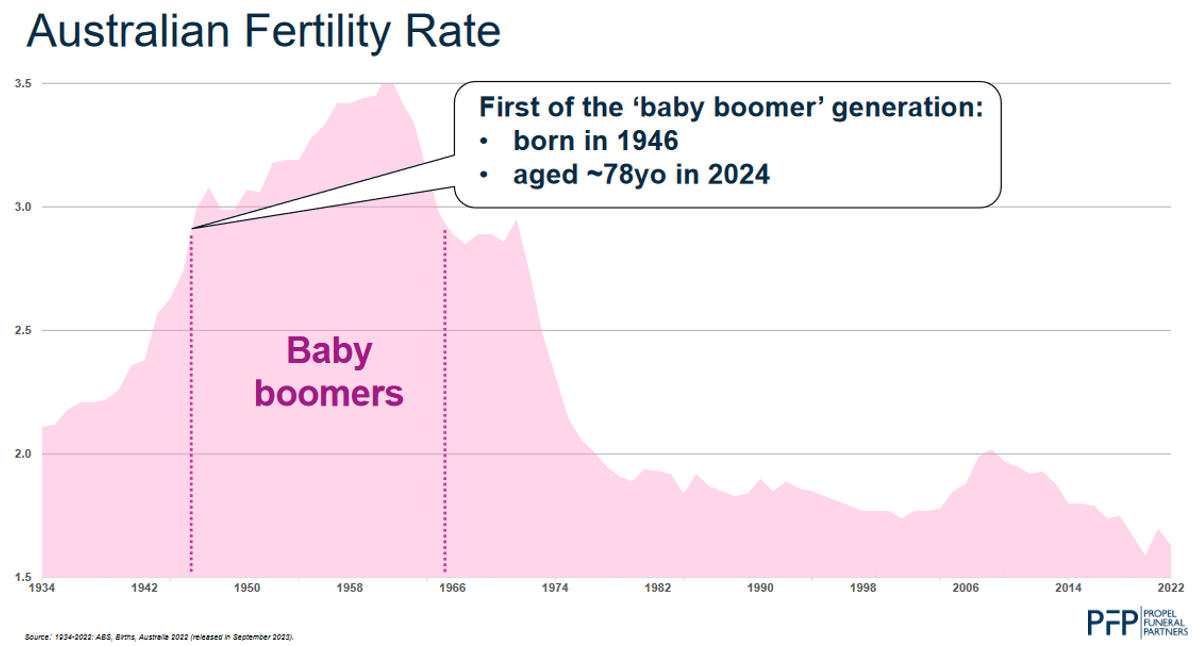
To address the challenges of an ageing Baby Boomer generation, the Australian government is implementing several measures:
- Encouraging higher birth rates: The government continues to support families through policies such as paid parental leave[2], childcare subsidies[3], and family tax benefits[4]. These measures aim to make it easier for families to have children and balance work and family responsibilities. Peter Costello’s 2004 baby bonus catch-cry of “one for mum, one for dad, one for the country” didn’t exactly lead to a wave of procreation. Jim Chalmers said in May 2024 “It would be better if birth rates were higher”, he doesn’t quite capture the headlines like Costello but the sentiment is there!
- Promoting skilled migration: Australia's immigration program remains a key strategy for addressing labor shortages and supporting economic growth. By attracting skilled migrants, the government aims to maintain a dynamic and productive workforce. Notably however after a recent high intake of ~740k migrant arrivals in FY2023 (net 528k) Australia has budgeted for a reduction in the number of migrant intakes for 2024-2025 down to net 260k
- Investing in health and social services: To support the ageing population, the Australian government is investing in healthcare and social services. Initiatives such as the National Disability Insurance Scheme (NDIS) and aged care reforms aim to improve the quality of life for older Australian. There are plenty of issues we can see with the NDIS but the sentiment behind it is a positive one. In our opinion the NDIS is in need of meaningful reform
- Enhancing workforce participation: The government is encouraging greater workforce participation among older individuals through policies that promote flexible work arrangements and lifelong learning. This approach aims to extend the working lives of older Australians and reduce the dependency ratio
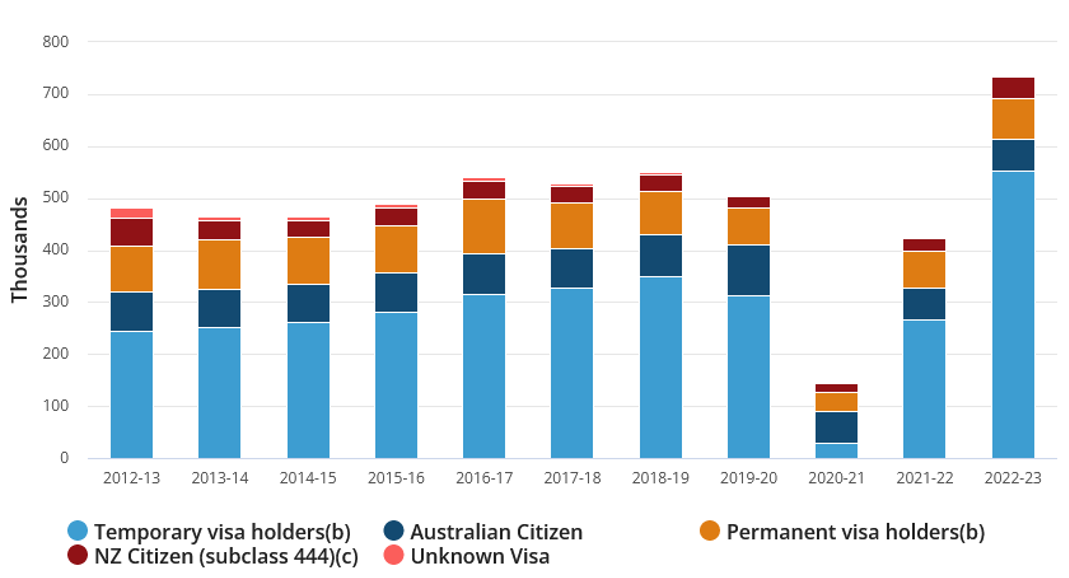
Demographic Impacts on ASX sectors
Tabled below we have summarized some of the potential impacts across all ASX sectors
For those that prefer to visualize we have compiled some key graphs below
Australia’s demographics are set to lead to a ‘death boom’
Recent ABS Data suggests the growth in spending per capita is growing at a faster rate the older we are. Is this indicating a structural tailwind as we age?
Source: Property Update, ABS Data
Asian demand for seaborne metallurgical coal appears to be increasing, driven by India
While Chinese steel production appears to be peaking.
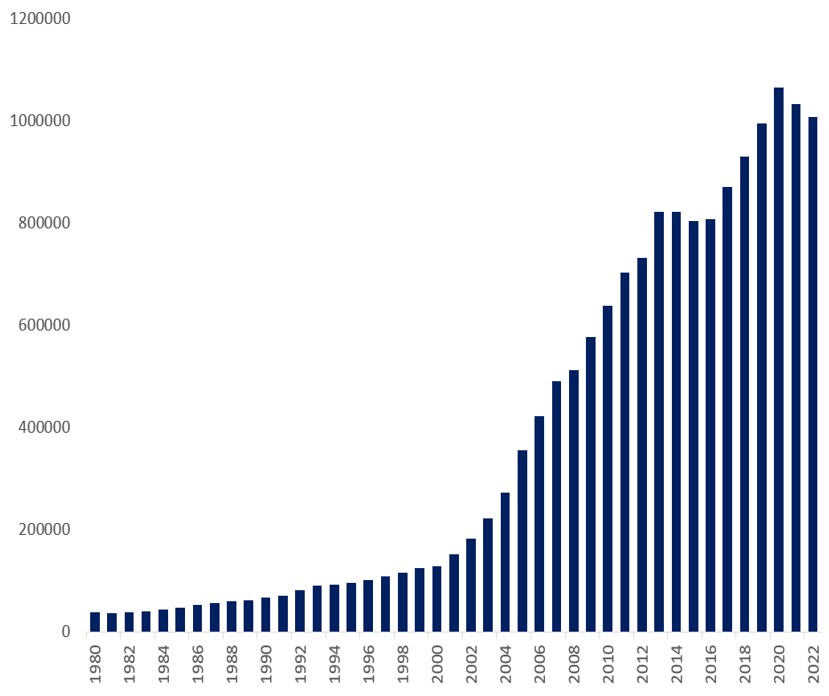
Does 16% of the world’s population still need to produce 53% of the world’s steel? Particularly if their population is declining and there is an oversupply of houses! (~1/3 of Chinese steel demand is driven from housing).
Meanwhile medical spending increases rapidly with age
Retirement villages in Australia have a double tailwind from the ageing population and underpenetrated market.
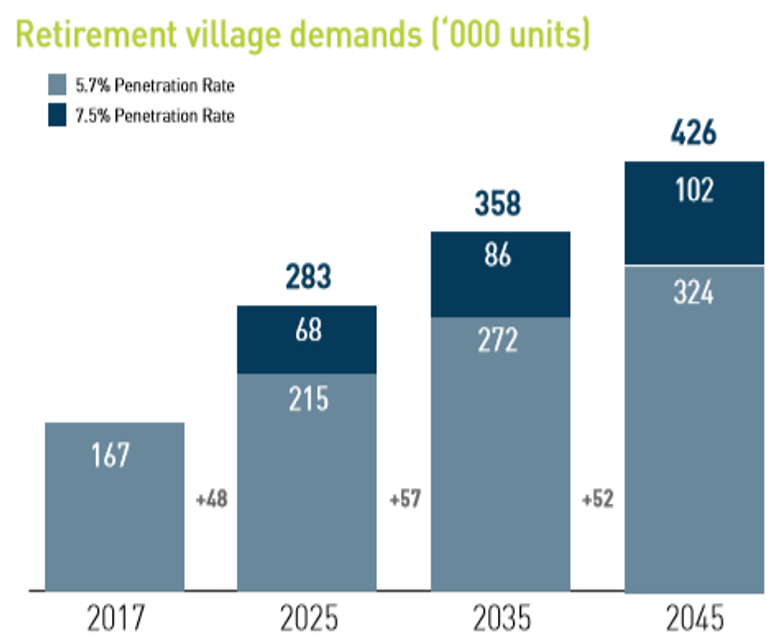
Closing
Although each portfolio holding has idiosyncratic merit underpinning it (a combination of quality, value and insight), demographics can be partly responsible for some of our positioning below.
- Healthcare (overweight) – CSL, RMD, TLX
- Agribusiness (increased protein intake and need for yield) – RIC, NUF
- Energy and Energy infrastructure – AZJ, AGL
- Real Estate (retirement living) – EGH
- Materials (Iron Ore underweight) – limited exposure ex MIN
You're still here? It's over. Go home. Go.
5 topics
51 stocks mentioned

